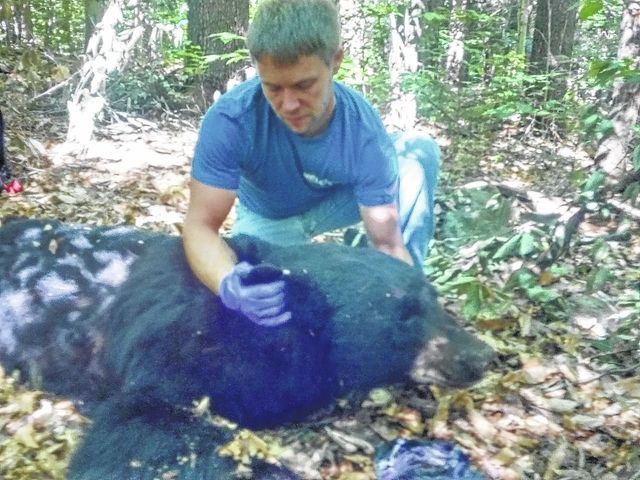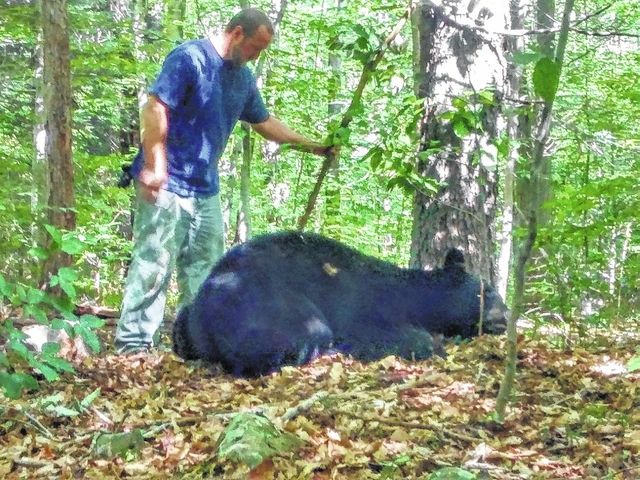Click here to subscribe today or Login.
LAPORTE TOWNSHIP, SULLIVAN COUNTY — The nearly 300-pound male black bear that Pennsylvania Game Commission biologist Kevin Wenner and his crew caught in a snare on Wednesday required a bit of work.
But it was nothing compared to the 25-pound juvenile bear they captured later in the day.
Wenner spent all of last week trapping bears on State Game Lands 13, battling extreme heat, dusty roads and biting bugs as part of an annual statewide project by the PGC. Using cable restraints and barrel traps, Game Commission personnel capture bears during the summer for tagging and research purposes. Each bear is fitted with ear tags and a corresponding identification number is tattooed inside its lip. A tooth is pulled to age each bear, which is then weighed and two vials of blood are drawn for research being conducted on tick-borne diseases and mange.
Finally, the information gleaned from the trapping effort yields reproductive data and aids in estimating the population.
Judging by Wenner’s success on SGL 13 last week, the population is doing pretty well. By the end of the day on Wednesday, Wenner trapped and processed 19 bears in six days. Last year, during two eight-day trapping periods in Sullivan and Bradford counties, 32 bears were captured.
“This is the most bears we ever captured on this particularly line during eight days since I started doing this in 2007,” Wenner said. “Based on hunter success, complaints and tagging efforts, there are more bears everywhere than there were 10 years ago.”
Wednesday’s success struck early in the morning when Wenner and his convoy pulled up to the second set location. While the rest of the group waited along a game lands road, Wenner walked a path into the woods and was greeted by a loud grunt. When he emerged, the group went to work knowing a bear was in the cable restraint.
Each set is baited with doughnuts that lead to the restraint. Wenner places the doughnuts strategically with the hope that any bear in the area will place its foot directly on the cable restraint. A trigger sprigs the cable around the bear’s foot, and the other end is clamped to a tree large enough to hold a big bruin.
The first bear of the day was a large 299-pound male. Wenner sedated it with a tranquilizer dart and, after a few minutes, the bear was immobilized. Wildlife Conservation Officer Rick Finnegan carefully squeezed ointment into the bear’s eyes to keep them moist while Wenner took its temperature to make sure it wasn’t stressed. After the bruin was processed, PGC employee Kurt Yuhas erected a tripod with a digital scale and winch to weigh the bear.
The bruin already had ear tags, and Finnegan checked the numbers and determined it was trapped last summer about three-quarters of a mile away and it weighed 230 pounds.
When the work was done, Wenner and Finnegan waited patiently near the bear as the tranquilizer wore off to make sure there were no problems, especially with the temperature hovering near 90 degrees.
“In the past I would’ve said this heat would impede our success, but we’re having a pretty stellar week so far,” Wenner said. “With the heat, we make sure to keep the sets in the shade and monitor the bear’s temperature frequently.”
Later in the morning the fifth set of the day yielded a second bear. As Wenner pulled up to the set, the ears of a small bear appeared above the vegetation. It was a cub that Wenner estimated weighed 25 pounds, and as the young bear became vocal, Wenner cautioned the group.
“We have a cub, we don’t know where the sow is and the vegetation is dark and shaded,” he said. “If she comes up, it’s not a big deal. Just stay together.”
Because there was no need to pull a tooth and age the cub, Wenner decided to process it without using a tranquilizer. Equipped with heavy, arm-length gloves, the group moved in on the small bear and Wildlife Conservation Officer Blake Barth held its head securely to the ground while Yuhas placed a tag in each ear. The cable restraint was removed from its foot and, with Barth holding it around the snout and Wenner and Finnegan lifting the hind end, the cub was released in the opposite direction and quickly scampered away.
“For a 25-pound animal, they’re much stronger than what you would think,” Barth said. “The main reason we process cubs like this is to avoid the stress of sedation. Anytime you don’t need to sedate an animal, the better.”
The trapline on SGL 13 has yielded plenty of bears and quite a few sightings. On Tuesday, a bear was spotted along the road eating a doughnut at one of the set locations. Wenner said it ran away, but another bear was already captured in the cable restraint.
At another location, Finnegan placed a trail camera near a set at 5 p.m., checked it at 6:30 p.m. and had photos of a bear investigating the set. The next morning there were more photos of a bear at the set.
“We haven’t reached our maximum carrying capacity for bears as far as habitat goes, but the population has reached its social carrying capacity based on the number of complaints we receive,” Wenner said. “This area is more than 49,000 acres and it’s remote, but the bears are doing very well here.”







